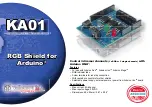
AT90S/LS4434 and AT90S/LS8535
94
4.
If a Chip Erase is performed (must be done to erase the Flash), wait t
WD_ERASE
after the instruction, give RESET a
positive pulse and start over from step 2. See Table 45 for t
WD_ERASE
value.
5.
The Flash or EEPROM array is programmed one byte at a time by supplying the address and data together with the
appropriate Write instruction. An EEPROM memory location is first automatically erased before new data is written.
Use Data Polling to detect when the next byte in the Flash or EEPROM can be written. If polling is not used, wait
t
WD_PROG
before transmitting the next instruction. See Table 46 for t
WD_PROG
value. In an erased device, no $FFs in
the data file(s) needs to be programmed.
6.
Any memory location can be verified by using the Read instruction that returns the content at the selected address
at the serial output MISO (PB6) pin.
7.
At the end of the programming session, RESET can be set high to commence normal operation.
8.
Power-off sequence (if needed):
Set XTAL1 to “0” (if a crystal is not used).
Set RESET to “1”.
Turn V
CC
power off.
Data Polling EEPROM
When a byte is being programmed into the EEPROM, reading the address location being programmed will give the value
P1 until the auto-erase is finished and then the value P2. See Table 42 for P1 and P2 values.
At the time the device is ready for a new EEPROM byte, the programmed value will read correctly. This is used to deter-
mine when the next byte can be written. This will not work for the values P1 and P2, so when programming these values,
the user will have to wait for at least the prescribed time t
WD_PROG
before programming the next byte. See Table 46 for
t
WD_PROG
value. As a chip-erased device contains $FF in all locations, programming of addresses that are meant to contain
$FF can be skipped. This does not apply if the EEPROM is reprogrammed without first chip-erasing the device.
Data Polling Flash
When a byte is being programmed into the Flash, reading the address location being programmed will give the value $FF.
At the time the device is ready for a new byte, the programmed value will read correctly. This is used to determine when the
next byte can be written. This will not work for the value $FF, so when programming this value, the user will have to wait for
at least t
WD_PROG
before programming the next byte. As a chip-erased device contains $FF in all locations, programming of
addresses that are meant to contain $FF can be skipped.
Figure 72.
Serial Programming Waveforms
Table 42.
Read Back Value during EEPROM Polling
Part
P1
P2
AT90S/LS4434
$00
$FF
AT90S/LS8535
$00
$FF
MSB
MSB
LSB
LSB
SERIAL CLOCK INPUT
PB7(SCK)
SERIAL DATA INPUT
PB5(MOSI)
SERIAL DATA OUTPUT
PB6(MISO)
















































